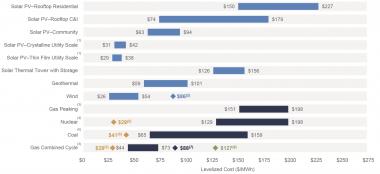Solar specialists join forces to hike returns
Companies from the entire PV value chain will combine and digitalise their learnings in a holistic plan to raise power plant yields and reduce downtimes.

Related Articles
A new collaboration between PV companies in Europe looks set to raise standards for plant build and operations.
The TRUST-PV initiative will bring together companies from the entire PV value chain to combine technology advances with industry learnings. Around 20 suppliers, developers, operators and data experts will work together to improve PV performance and reduce the levelised cost of energy (LCOE). The four-year project will last until 2023 and has received 12 million euros ($14.5 million) from the European Union.
Levelised cost of energy by generation type
(Click image to enlarge)
Source: Lazard's Levelized Cost of Energy Analysis (LCOE 14.0), October 2020
The partners will use digitalisation to connect learnings in design, modelling, monitoring and inspections, David Moser, project coordinator at Eurac Research, told Reuters Events.
This will allow the tracing of performance issues at a "single component level" and the creation of digital twins for better modelling, Moser said. 3D design and BIM (building information modelling) will be used to create more accurate yield assessments and improve inspection efficiency and fault prevention.
The partners aim to increase the yield of solar plants by over 10% and reduce downtimes by 80%, he said.
The project has been set up to foster collaboration between specialist domains. Experts in operations and maintenance (O&M) and asset management will be involved from the start of the supply chain process, Emanuel Vallarella, research engineer at technology group Huawei, another TRUST-PV participant, said.
Reduced component degradation should also lengthen plant lifespans, compounding the benefits for plant owners.
The gains made through the project should increase the internal rate of return (IRR) for large-scale plants by 50%, Moser said.
Conversion costs
The TRUST-PV participants will be responsible for different elements of the project and will feed results into a decision platform supported by AI. Costs will be assigned to actions and the AI will be "reinforced" by operator feedback, Moser said.
Improvements in monitoring and diagnostics will reduce PV inverter costs, Carmelo Connelli, project manager at Enel Green Power, a plant operator and TRUST-PV partner, said.
Inverters convert direct current (DC) from solar energy into alternating current (AC) for the power grid and represent 5 to 10% of utility-scale solar costs. Inverters are typically replaced at least once over the lifetime of the plant and make up around a quarter of O&M costs, according to data gathered by the US National Renewable Energy Laboratory (NREL) in 2018.
US solar O&M costs by category (2018)

Source: National Renewable Energy Laboratory (NREL)
Inverter suppliers are constantly improving their technology, offering higher voltage, improved access and better control functionality. The TRUST-PV partners will look to integrate automatic or semi-automatic diagnostics and field inspection processes in inverter hardware and software. Aerial imaging and other techniques will also be used to avoid disconnecting systems. Many large solar operators are now using drones to speed up inspections at large sites and reduce labour costs.
The project partners will also aim to identify the optimal DC to AC ratio in terms of output and inverter reliability, Roland Huempfner, head of Huawei’s European energy competence centre, told Reuters Events.
A high DC to AC ratio increases inverter utilisation and can offer a more stable electricity injection but it can also impact inverter reliability, Huempfner said.
"There needs to be further study on the stress that the inverter has with a high DC/AC ratio in different climate conditions - temperature, altitude, humidity,..." he said.
Predictable power
The research will also help operators manage intermittency as subsidies expire and wholesale market risks grow. Large fleet operators and utilities are increasingly turning to advanced forecasting and analytics solutions to mitigate swings in solar and wind resources.
TRUST-PV partner Reuniwatt will use cloud forecasting to optimise short-term operations. The company uses images from infrared all-sky imaging cameras and analytics to improve intra-day solar forecasts. Historic data and algorithms are used to predict near-term production.
“When you have clouds passing above a PV plant, production can drop by 80% in seconds, so it’s crucial to know this in advance," Marion Lafuma, business development manager at Reuniwatt, said.
Better forecasting of this power drop will improve plant management and the sizing of batteries on storage projects, she noted.
Separately, Reuniwatt is using satellite data to forecast solar production up to six hours ahead and will feed these results into the project.
The collaborative approach to TRUST-PV should also reduce the cost of capital and boost investments in new projects, Vallarella said.
The new performance standards established by the project could "set the path to an ever-decreasing LCOE,” he said.
Reporting by Neil Ford
Editing by Robin Sayles

